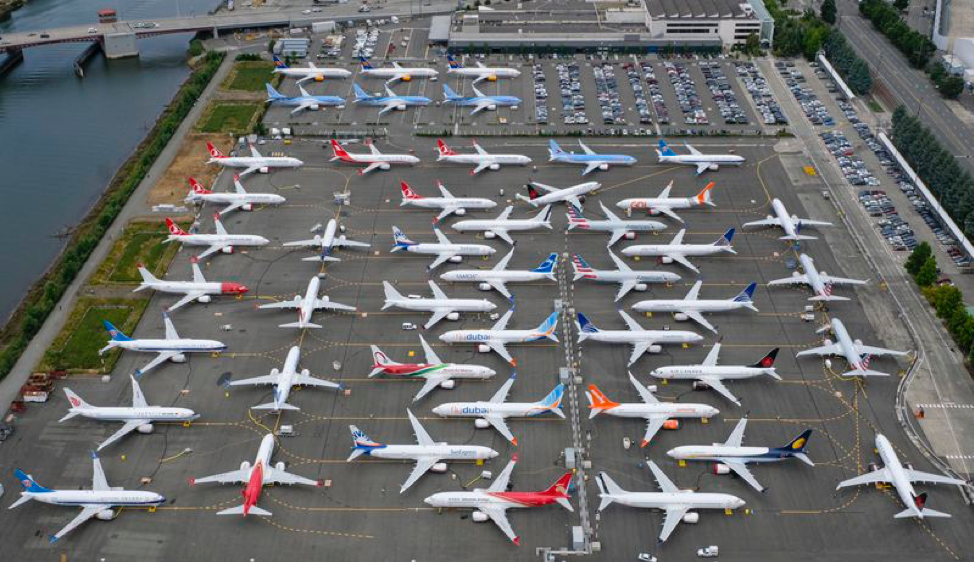
Grounded 737 Max jets
After two fatal crashes in 2018 and 2019, the Boeing 737 Max has been grounded since March 10, 2019. Airline companies purchased this aircraft not knowing it was inherently flawed; so, now, they are stuck with planes that they cannot use. This is costing them in more than one way.
The airline industry relies on land, hangars and gates rented from airports. Every airline company rents a certain number of gates that they use for passengers, a certain amount of land they use to park planes and a certain number of hangars to maintain those planes. The nature of this business is that the planes circulate between the gates (flight), parking lots and hangars so that all of the planes are used to maximize profit. When the 737 Max was grounded in March 2019, this forced airline companies to reschedule flights, issue refunds and allocate other planes accordingly. The 737 Max planes are now parked on land for which the companies are paying. In essence, the companies have useless aircraft that costs them money – dead-weight.
As of October 24, 2019, American Airlines (owns 24 737 Max planes) paid $540 million, and Southwest (owns 21 737 Max planes) paid $435 million – $1 billion in total.[1] American Airlines cancelled 9,500 flights just in the third quarter of 2019 as a result.[2]
This is where Boeing comes into the picture. Because the grounding had such a large impact on the top-line and bottom-line for airliners, airline companies started negotiations with the manufacturer, Boeing, to compensate them. Boeing set aside $5 billion for this reason.[3]

Boeing CEO, Dennis Muilenburg, at a Senate hearing October 29, 2019. Pictures of the crashes victims surround him.
The 737 Max planes that have been delivered so far amount to 387 globally and pending orders for 400 more have been cancelled.[4] The 737 Max costs between $99.7 million to $134.9 million depending on the model.[5] Boeing has suffered a minimum of $39.88 billion and a maximum of $53.96 billion in unrealized revenues on the pending orders.
Boeing
is the largest exporter and one of the largest employers in the US.[6]
On top of a heavy trade imbalance due to the US-China trade war, Boeing’s cessation
of producing 737 Max jets has further hindered GDP and manufacturing exports.
This resulted in a drop of 1.3 percent of durable-goods orders in the second
quarter and $2 billion loss in aircraft and parts sales. Bloomberg reports that
737 Max order book was worth $600 billion.[7]
Bloomberg claims that the impact of the 737 Max crisis affected .2 percent of
the second quarter’s GDP. Also, Investopedia reports that the impact would be greater
than that of the 2019 government shutdown, which was $4 billion.[8]
[9]
[1] https://www.cnn.com/2019/10/24/business/american-airlines-southwest-boeing-737-max-costs/index.html
[2] https://www.cnn.com/2019/10/24/business/american-airlines-southwest-boeing-737-max-costs/index.html
[3] https://www.cnn.com/2019/10/24/business/american-airlines-southwest-boeing-737-max-costs/index.html
[4] https://www.cnn.com/2019/10/24/business/american-airlines-southwest-boeing-737-max-costs/index.html
[5] http://www.boeing.com/company/about-bca/#/prices
[6] https://www.investopedia.com/how-boeing-s-737-max-crisis-is-hurting-u-s-gdp-growth-4694349
[7] https://www.investopedia.com/how-boeing-s-737-max-crisis-is-hurting-u-s-gdp-growth-4694349
[8] https://www.cnn.com/2019/09/17/politics/government-shutdown-cost-study/index.html
[9] https://www.investopedia.com/how-boeing-s-737-max-crisis-is-hurting-u-s-gdp-growth-4694349